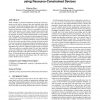Free Online Productivity Tools
i2Speak
i2Symbol
i2OCR
iTex2Img
iWeb2Print
iWeb2Shot
i2Type
iPdf2Split
iPdf2Merge
i2Bopomofo
i2Arabic
i2Style
i2Image
i2PDF
iLatex2Rtf
Sci2ools
IPSN
2011
Springer
2011
Springer
Localising speech, footsteps and other sounds using resource-constrained devices
While a number of acoustic localisation systems have been proposed over the last few decades, these have typically either relied on expensive dedicated microphone arrays and workstation-class processing, or have been developed to detect a very specific type of sound in a particular scenario. However, as people live and work indoors, they generate a wide variety of sounds as they interact and move about. These human-generated sounds can be used to infer the positions of people, without requiring them to wear trackable tags. In this paper, we take a practical yet general approach to localising a number of human-generated sounds. Drawing from signal processing literature, we identify methods for resource-constrained devices in a sensor network to detect, classify and locate acoustic events such as speech, footsteps and objects being placed onto tables. We evaluate the classification and time-of-arrival estimation algorithms using a data set of human-generated sounds we captured with se...
| Added | 30 Aug 2011 |
| Updated | 30 Aug 2011 |
| Type | Journal |
| Year | 2011 |
| Where | IPSN |
| Authors | Yukang Guo, Mike Hazas |
Comments (0)

